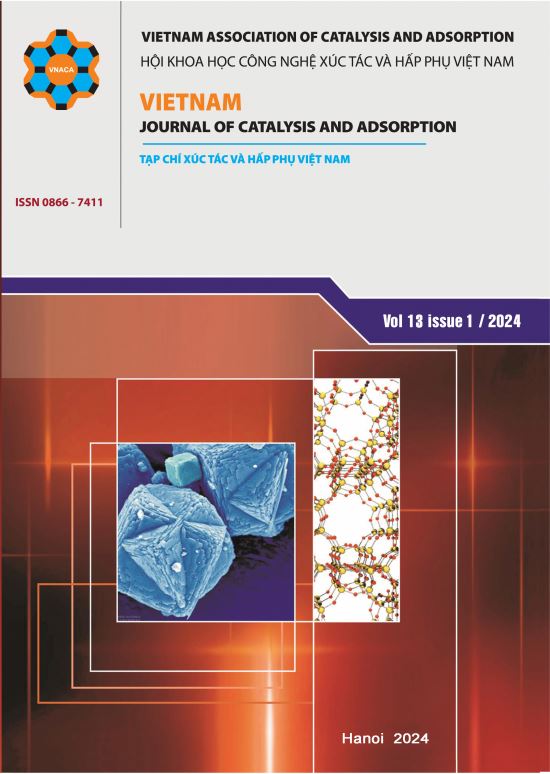Research on adsorption – desorption the ability of hydroxyapatite for Co2+ ions and recovery cobalt by electrochemical deposition
DOI:
https://doi.org/10.62239/jca.2024.019Keywords:
Hydroxyapatite, adsorption, desorption, recovery, Co2+ ionAbstract
Hydroxyapatite has a nanostructure with the chemical formula of Ca10(PO4)6(OH)2. In this paper, hydroxyapatite is used to study the ability to adsorb Co2+ ions. The influence of some factors on Co2+ adsorption capacity and efficiency has been studied. Co2+ adsorption efficiency and capacity reached 85.08% and 6.38 mg/g under the suitable conditions: hydroxyapatite mass of 0.2 g/50 mL solution, 50 mg/L initial Co2+ concentration, pH 5.0, exposure time of 30 minutes at room temperature (25oC). The process of desorption of Co2+ from the loaded adsorbent and recovery of metallic Co was also studied. Cobalt recovery efficiency reached 94.58% under appropriate conditions: applied current 7.5 mA, electrolysis time of 10 hours, loaded hydroxyapatite mass of 0.1 g, temperature 60oC. After desorption process, the adsorbent was regenerated for further studies. The adsorption isotherm was studied based on two Langmuir and Freundlich models. The adsorption kinetics were examined using two pseudo-first-order and pseudo-second-order kinetic models.
Downloads
References
F. Ma, W. Zhu, W. Cheng, J. Chen, J. Gao, Y. Xue, Y. Yan, J. Water Proc.engineering 53 (2023) 103635. https://doi.org/10.1016/j.jwpe.2023.103635
J. Kushwaha, R. Singh, Inorg. Chem. Commun. 152 (2023) 110721. https://doi.org/10.1016/j.inoche.2023.110721
H. Motaghi, P. Arabkhani, M. Parvinnia, A. Asfaram, Sep. Purif. Technol. 284 (2022) 120258. https://10.1016/j.seppur.2021.120258
M. Rajiv Gandhi, G.N. Kousalya, S. Meenakshi, Int. J. Biol. Macromol. 48 (2011) 119-124. https://doi.org/10.1016/j.ijbiomac.2010.10.009
P. Chand, Y.B. Pakade, Environ Sci Pollut Res Int, 22 (2015) 10919-10929. https://doi.org/10.1007/s11356-015-4276-2
X. Liu, H. Yin, H. Liu, Y. Cai, X. Qi, Z. Dang, J Hazard Mater 443 (2023) 130167. https://doi.org/10.1016/j.jhazmat.2022.130167
I. Anastopoulos, A. Mittal, M. Usman, J. Mittal, G. Yu, A. Núñez-Delgado, M. Kornaros, . Mol. Liq. 269 (2018) 855-868. https://doi.org/10.1016/j.molliq.2018.08.104
H. Li, J. Zhang, Y. Zhang, H. Huang, H. Ou, Y. Zhang, Sep. Purif. Technol. 319 (2023) 124058. https://doi.org/10.1016/j.seppur.2023.124058
M.A. Islam, M.J. Ahmed, W.A. Khanday, M. Asif, B.H. Hameed, Ecotoxicol Environ Saf 138 (2017) 279-285. https://doi.org/10.1016/j.ecoenv.2017.01.010
Y. Wu, J. Ming, W. Zhou, N. Xiao, J. Cai, Sci Total Environ, 884 (2023) 163887. https://doi.org/10.1016/j.scitotenv.2023.163887
M. Hamzaoui, B. Bestani, N. Benderdouche, J. Mater. Environ. Sci. 9(4) (2018) 1110-1118. https://doi.org/10.26872/jmes.2018.9.4.122
V.T. Le, T.K.N. Tran, D.L. Tran, H.S. Le, V.D. Doan, Q.D. Bui, H.T. Nguyen, J. Dispers. Sci. Technol. 40 (2019) 1761-1776. https://doi.org/10.1080/01932691.2018.1541414
V.X. Minh, K.T.T. Dung, P.T. Lan, L.T.M. Hanh, N.T. Dung, Vietnam J. Chem. 58 (2020) 358-363. https://doi.org/10.1002/vjch.2019000195
P. Sebastián, E. Gómez, V. Climent, J.M. Feliu, Electrochem. commun. 78 (2017) 51-55. https://doi.org/10.1016/j.elecom.2017.03.020
A. Shishov, A. Bulatov, M. Locatelli, S. Carradori, V. Andruch, Microchem. J. 135 (2017) 33-38. https://doi.org/10.1016/j.microc.2017.07.015
J.G.d.R.d. Costa, J.M. Costa, A.F.d. Almeida Neto, Metals, 12 (2022) 2095. https://doi.org/10.3390/met12122095
D.T. Le, T.P.T. Le, H.T. Do, H.T. Vo, N.T. Pham, T.T. Nguyen, H.T. Cao, P.T. Nguyen, T.M.T. Dinh, H.V. Le, D.L. Tran, J. Chem. 2019 (2019). https://doi.org/10.1155/2019/8620181
N. Gupta, A.K. Kushwaha, M.C. Chattopadhyaya, J. Taiwan Inst. Chem. Eng. 43 (2012) 125–131. https://doi.org/10.1016/j.jtice.2011.07.009
Y. Si, J. Hou, H. Yin, A. Wang, J. Nanosci. Nanotechnol. 18 (2018) 3484-3491. https://doi.org/10.1166/jnn.2018.14631
Q. Rayée, T. Doneux, C. Buess-Herman, Electrochim. Acta 237 (2017) 127-132.
https://doi.org/10.1016/j.electacta.2017.03.182
W. Dou, Z. Deng, J. Fan, Q. Lin, Y. Wu, Y. Ma, Z. Li, Appl. Clay Sci. 229 (2022) 106693. https://doi.org/10.1016/j.clay.2022.106693
R. Foroutan, S.J. Peighambardoust, A. Ahmadi, A. Akbari, S. Farjadfard, B. Ramavandi, J. Environ. Chem. Eng. 9 (2021) 105709. https://doi.org/10.1016/j.jece.2021.105709
Y. Feng, J.L. Gong, G.M. Zeng, Q.Y. Niu, H.Y. Zhang, C.G. Niu, J.H. Deng, M. Yan, J. Chem. Eng. 162 (2010) 487-494. https://doi.org/10.1016/j.cej.2010.05.049
Downloads
Published
Issue
Section
How to Cite
Share
Funding data
-
Bộ Giáo dục và Ðào tạo
Grant numbers B2022-MDA-03










